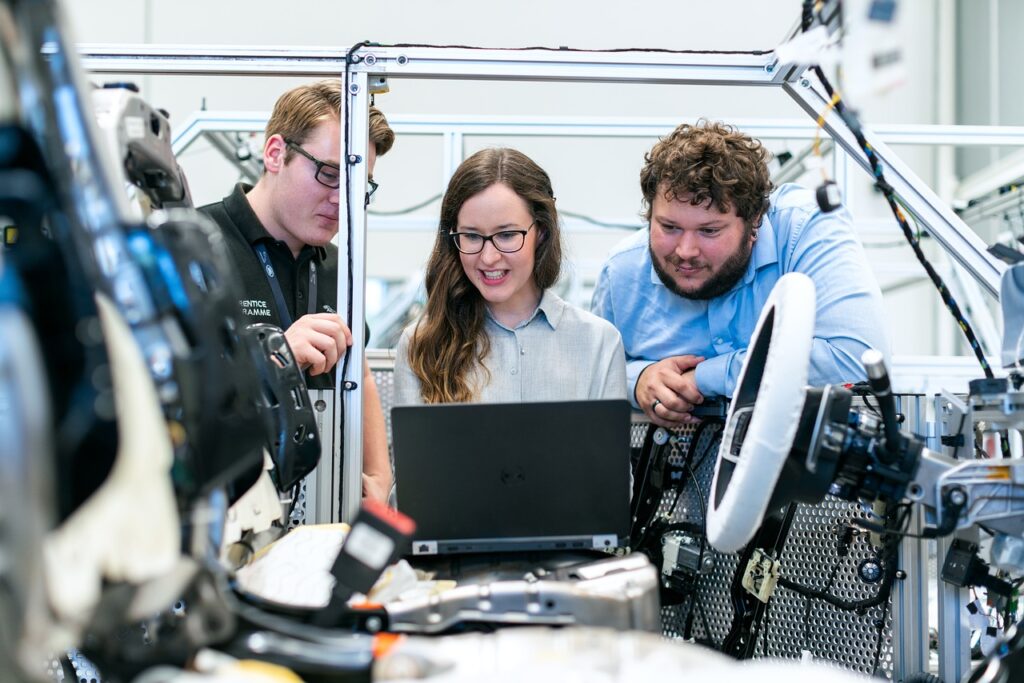Uncover the history of the first internal combustion engine with us today!
With the development of human civilization, the diverse needs of people are increasing. In response to the need for communication systems, people invented various vehicles through their talent and labor. The invention of the first internal combustion engine is one of these. There is no end to the curiosity about the invention and rise of the modern engine. This article is written in that light, which may answer many questions in your mind.
An engine is an automatic machine. It is a type of prime mover that operates by converting thermal energy, through the combustion of fuel, into mechanical energy to drive other machines. There are basically two types of engines: 1. internal combustion engine, and 2. External combustion engine

What is an internal combustion engine?
An internal combustion engine is a type of engine that produces energy by burning a fuel mixture in the combustion chamber, or interior, of the engine.
History of First Internal Combustion Engine:
History tells us that in 1866, Nikolas A Otto of Germany invented the four-stroke petrol engine and added it to motor vehicles. In 1885-1886, Gottlieb Daimler invented the high-speed internal combustion engine, and in the same year, Karl Benz of Germany developed a three-wheeled petrol-powered vehicle. Over time, the internal combustion engine became regarded as the primary engine in motor vehicles.
Internal combustion engine industrial revolution

The internal combustion engine Industrial Revolution or development of the automobile did not happen overnight. The modern automobile was born as a result of many pursuits over a long period of time. In ancient times, animals such as donkeys, horses, and cows were used to transport people and goods. In 1500 AD, Leonardo da Vinci expressed the idea of the automobile. In 1680, Sir Isaac Newton proposed the idea of driving a car using a steam jet. Then, Christian Huygens powered a single-cylinder engine vehicle by burning gunpowder. In 1769, Captain Nicolas Cugnot of France invented a three-wheeled vehicle powered by a steam engine, driving it for 15 minutes at a speed of 4 km per hour. For this achievement, he is considered the father of the automobile. In 1802, England’s Richard Trevithick built the first crankshaft steam-powered automobile engine. In 1821, Julian Griffiths of England developed a more comfortable steam-powered car.
In 1863, France’s Lenoir built a steam engine-powered motor vehicle with a single-cylinder engine. This vehicle traveled about 10 km. In 1866, Nikolaus A. Otto of Germany invented the four-stroke petrol engine and incorporated it into automobiles, which is why Germany is called the birthplace of the automobile. In 1885-86, Gottlieb Daimler invented the high-speed internal combustion engine and installed it in a two-wheeler. In the same year, Germany’s Karl Benz installed petrol engines in three-wheelers, with a speed of eight miles per hour. Then, in 1889, Daimler produced a four-wheeled motor vehicle. In 1895, Panhard invented the modern motor vehicle with a vertical engine, including an engine, power transmission system, brake system, and clutch. Meanwhile, in 1893, two American brothers, Charles Duryea and Frank Duryea, built a petrol engine-powered motor vehicle. Thus, during the First World War, the motor vehicle body evolved from wood to metal, giving rise to the modern motor vehicle.
The First internal combustion engine (ICE) played a key role in shaping the Industrial Revolution, especially during its later stages in the late 19th and early 20th centuries. While the first phase of the Industrial Revolution (around 1760-1830) was powered largely by steam engines, the advent of the internal combustion engine helped revolutionize industries in several ways. Here’s a breakdown of its impact:
1. Transition to More Efficient Power:
- Earlier Power Sources: During the first Industrial Revolution, steam engines were the primary source of industrial power. These engines were bulky, inefficient, and required large amounts of coal.
- ICE Advantages: The internal combustion engine, particularly after the late 1800s, was smaller, more efficient, and more adaptable. It allowed for more compact and versatile power sources, making it possible to power a wider range of machines, vehicles, and tools.
2. Impact on Transportation
- Automobiles: The development of the internal combustion engine led to the creation of the automobile, most famously by innovators like Karl Benz (who built the first practical automobile in 1885-1886). This transformed transportation, making it faster and more accessible than ever before.
- Air and Sea Travel: ICEs also enabled the development of airplanes (like the Wright brothers’ first flight in 1903) and more efficient ships. This helped boost global trade and communication.
3. Growth of the Oil Industry
- The rise of internal combustion engines created a massive demand for gasoline and diesel fuel, which led to the rapid growth of the oil industry. The exploration, extraction, and refinement of oil became integral to powering engines, and it reshaped global economies and geopolitics.
4. Boost to Manufacturing and Mechanization
- Factory Production: ICEs allowed factories to move beyond reliance on water or steam-powered systems. Small, portable engines powered machines that were not tied to specific locations, leading to increased production and the spread of industrialization to more regions.
- Agriculture: Internal combustion engines also found their way into agriculture, with gas-powered tractors replacing steam-powered models and animal labor. This mechanization boosted crop yields and efficiency.
5. Urbanization and Society
- Cities and Infrastructure: The internal combustion engine, through cars, trucks, and public transport systems (like buses and trains), contributed to urbanization by making it easier for people to travel to cities for work. This led to the rapid expansion of cities, a core feature of the Industrial Revolution.
- Workforce Changes: The widespread use of engines in agriculture and manufacturing also affected labor needs, requiring fewer manual workers but more skilled operators of engines and machinery.
6. Environmental Effects and Long-Term Impact
- Although the ICE powered industrial and economic growth, it also set the stage for many of the environmental challenges we face today, such as air pollution, carbon emissions, and climate change. The reliance on fossil fuels has had long-lasting consequences for the planet’s ecosystems.
How did the internal combustion engine impact society?
Discover how combustion engines revolutionized daily life and transformed our world!
a) Use of Petrol Engine as Prime Mover:
As a Motor Vehicle Engine: The use of petrol engines in cars, jeeps, motorcycles, baby taxis, etc., is popular. Therefore, the petrol engine is widely used as the prime mover for small motor vehicles.
As a Prime Mover for Small Power Plants: Petrol engines are exclusively used in small power plants for shops, homesteads, and commercial centers. These power plants are operated manually or with a self-starting process. They are typically used to temporarily meet power demands when there is a power outage.
As an Engine for Lawn Mowers: Petrol engines are also used as prime movers for lawnmowers and small tillage machines.
(b) Use of diesel engine as prime mover:
- As an Engine for Medium and Heavy Vehicles: Diesel engines are popular as engines or prime movers for buses, trucks, jeeps, microbuses, trains, ships, etc. The power of diesel engines is greater than that of other engines.
- I.C. Engine Power Plant as Prime Mover: The diesel engine is considered the “best prime mover” for internal combustion (I.C.) engine power plants. This engine is widely used in diesel power plants with capacities ranging from 50 kW to 300 MW.
- As a Prime Mover for Driving Accessories such as Pumps and Rice Mills: In earlier times, when electricity was scarce and consumption was low, diesel engines were used as prime movers for operating pumps and other accessories, including rice mills. In remote village areas where electricity is still unavailable, diesel engines continue to be used as prime movers to run these machines.
(c) Use of Gas Turbine as Prime Mover: The gas turbine is used as a prime mover in the following areas:
- As a Motor Vehicle Engine: Today, gas turbines are popularly used as internal combustion (IC) engines for motor vehicles. Due to the high power output, low fuel consumption, and reduced environmental pollution of gas turbines, their use in motor vehicles is increasing day by day in developed countries.
- Gas Turbine as Prime Mover in Power Plants: A gas turbine power plant is a type of IC engine power plant. Natural gas is mainly used as fuel in gas turbines. In countries where natural gas is abundant, such as ours, gas turbines are becoming popular as prime movers. The capacity of these power plants ranges from 30 kW to 40 MW.
- As Prime Movers in Aviation for Airplanes and Jets: Propellers and jet propulsion are used to propel aircraft. In this system, a gas turbine drives a propeller, and its exhaust gas is used to produce a propulsion jet. The engine used in this combined process is called a “prop-jet” engine. This type of jet engine is used in heavy bombers and large civilian passenger aircraft to achieve optimal propulsion results.
Internal combustion engine environmental impact

The internal combustion engine has been used as the prime mover in the above-mentioned areas, significantly improving our standard of living and ensuring comfortable travel and living. The internal combustion engine has contributed immensely to the development of civilization, driving business in commercial centers. Internal combustion engines (ICE) significantly harm the environment through the release of pollutants such as carbon dioxide (CO2), nitrogen oxides (NOx), and particulate matter (PM). These emissions contribute to air pollution, global warming, and climate change by increasing greenhouse gas concentrations. Additionally, ICE produces harmful substances that degrade air quality, leading to respiratory issues and other health problems in humans. The burning of fossil fuels in these engines depletes natural resources, and oil spills or leaks from vehicles can contaminate soil and water. Overall, ICE plays a substantial role in environmental degradation, pushing for the need for cleaner alternatives.
Conclusion:
The internal combustion engine played a transformative role during the second phase of the Industrial Revolution. It enabled new technologies, industries, and efficiencies that reshaped the economy, the environment, and society. Its influence continues to this day, with ICEs powering much of the global transportation network and manufacturing industries.

